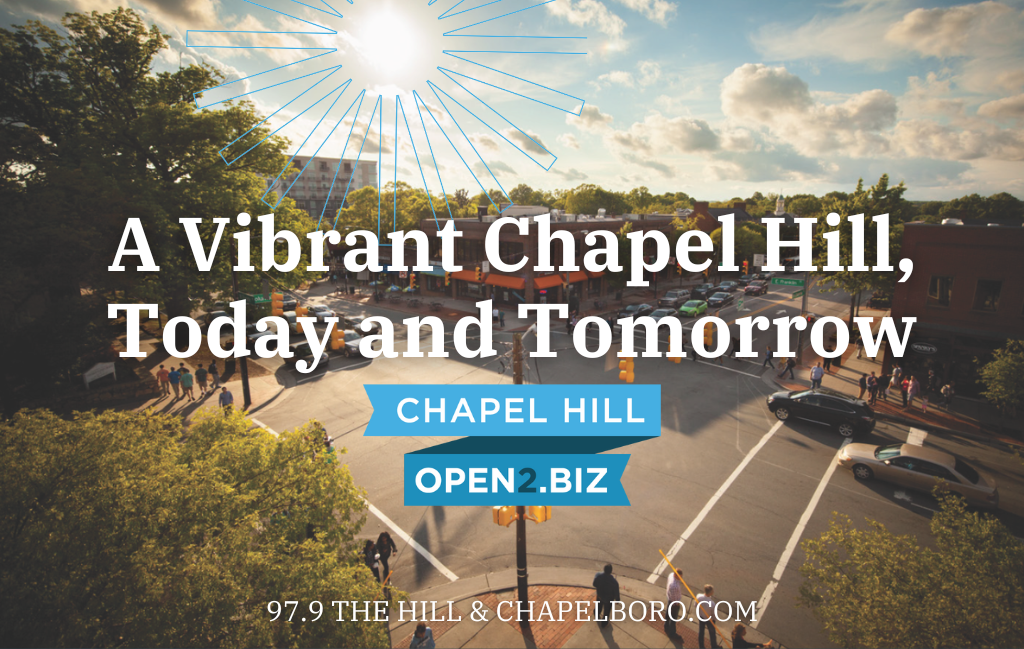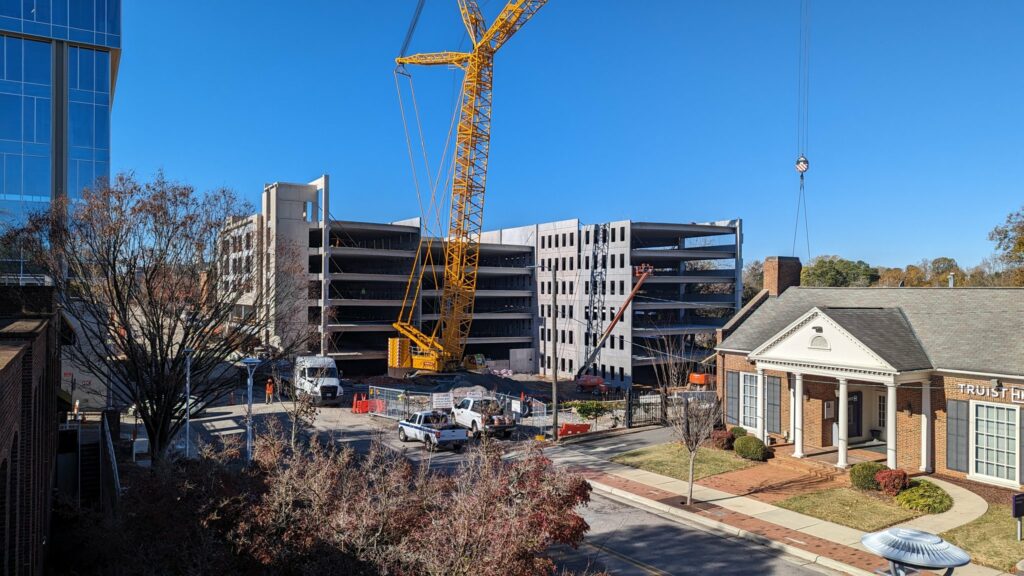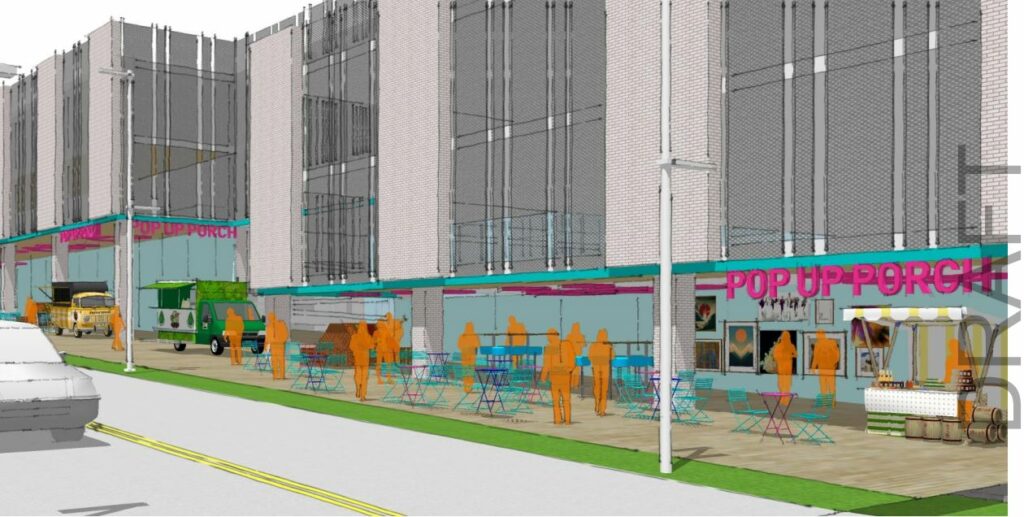
Welcome to “A Vibrant Chapel Hill, Today and Tomorrow!” a monthly interview series with Chapel Hill’s Economic Development and Parking Services office, exclusively on 97.9 The Hill WCHL & Chapelboro.com.
Every month you’ll get updates from department staff and special guests, to learn about initiatives the town is taking to ensure a Vibrant Chapel Hill, Today and Tomorrow.
This month’s special guest is Chris Blue, Town Manager of Chapel Hill!
Listen to the full conversation with Aaron Keck or read the transcript below, which is lightly edited for clarity.
Aaron Keck: Joined in the studio today by Town Manager, Chris Blue, to talk about a bunch of things that are ongoing and in some cases, just wrapping up, in Chapel Hill. Chris, thank you so much for being with us today.
Chris Blue: Thanks so much for having me. It’s always a pleasure to be with you.
Keck: First of all, Estes Drive, which is now back open for traffic after two years. I know everyone is excited about that in town and I’m sure you are too.
Blue: Very excited. That is one of those projects that has seemingly gone on for so long, and we know it’s been an inconvenience for everybody in the community, those folks who are moving around the community, particularly those neighborhoods immediately adjacent to the work site. And so we are thrilled, as I know our community members are, that the road opened to two-way traffic last week. There’s still some punch work to be done. There will be some resurfacing that will happen overnight in these coming weeks. But just a really successful project, it looks great. It has given us a new wide side path and elevated space for people to walk and roll along the side of the road. And then later as we approach “back to school,” we will be hosting what we’re calling the “Estes Drive Roll and Stroll,” which is a celebration for folks to come out and use that path, and imagine what going back to school and using that path will be like. We ask folks to come out and bring their bikes, their wheelchairs, their walking shoes, their running shoes, you name it, to celebrate this new safe route as school cranks back up.

Keck: I know everyone is so excited to get out there on the road and the connectivity project is so important for walking and biking and everything else, from an economic development perspective, why is this such a big deal for Chapel Hill?
Blue: I think this project, as well as some others we will talk about today, are an example of our Town Council’s larger interests around creating connected communities, creating accessible spaces for everybody. The Town Council adopted the Complete Community Framework a couple of years ago, which is this kind of planning philosophy about easy connected access to most any amenity that you might want in your life. And safe ways to get there that do not necessarily require you to get in a car, that could be used by our transit system, it could be our greenway system that we’re always trying to enhance. And those kinds of projects make a community a desirable place for people to live, to come and start their business, to grow their families. And so when you think about vibrancy, creating a space where everybody feels safe to move around and make their way throughout the community in a way that fits their lifestyle, I’m not sure you could be more vibrant than that.
Keck: And that’s all over town. There’s also a connectivity project on Homestead Road too, right?
Blue: That’s right. In anticipation of one of the town’s affordable housing projects on Homestead Road that is just getting underway, we are doing sidewalk and bike lane improvements along Homestead Road. Those are in the final stretch and should be finished by the end of the summer. If you’ve driven through that area at all, you will see lots of work’s been happening the last few months. This is another very important route to get people to school. So we’re thrilled about the safety and accessibility enhancements that are happening there too.
Keck: I love the focus on school as opposed to getting to and from work because that’s extremely important.
Blue: That’s right. As we think about the long-term greenway opportunities for connectivity, and in fact if you look at our greenway system now, there are people commuting to their jobs, going to the grocery store; they’re going to the schools and the university. So we’re already seeing uses of those amenities that I think really bear out what we’re trying to achieve to make a really connected community.
Keck: Speaking with Chris Blue Chapel Hill Town Manager, talking about a Vibrant Chapel Hill today and tomorrow. That’s the title of the monthly feature. And we’re focusing on a number of different town projects that are ongoing or wrapping up a lot of connectivity projects, but also a lot of projects that are enabling people to get downtown and get around downtown, including the big parking deck that’s going up on East Rosemary Street.
Blue: That’s really exciting. We could, and hopefully will, dedicate a whole session to just that, but in early August we will open up the East Rosemary Street parking deck. We’re really excited about that. That’s another project that’s taken a long time. What we know is that projects of this scale, whether it’s Estes Drive project or the Rosemary Street parking deck project, they’re always unanticipated conflicts that pop up, or things that you didn’t expect, and you just have to work around those issues. The deck has had certainly its share of those but go by and take a look at it. It’s really looking good. It fits so nicely with how that block is starting to redevelop and shape up. We’re very excited about that. It’s going to be a great complement to the innovation hub right across the street and it’s really starting to look like a finished product now. It’s going to have some state-of-the-art parking technology, we’re very excited about it. We will have more to say about that, including the ribbon cutting, later on this summer. I do want to mention, as we’re talking about parking and vibrancy and thinking about vibrancy downtown, we are doing free parking on Saturdays in July. And of course Sunday is always free. So encourage folks to come downtown and take advantage of shopping and dining and just have a walk in our beautiful downtown.

Keck: Have you considered free parking on Saturdays all year round?
Blue: We get that question often, and it’s certainly something that comes up from time to time. Charging for parking does a couple of things. One, it helps support the enterprise. To build and maintain an amenity so people can actually park does cost money. And one way we pay for that and the maintenance of those kinds of amenities is through charging. The other thing, and I think our neighbors in Carrboro are wrestling with a little bit right now, is the notion that some reasonable charging for parking actually stimulates turnover in those parking places. In a college community like ours, we know that folks who live off campus and are trying to get to campus can get very creative about where they put their automobiles. And one way to deter that and continue to keep turnover and spaces open for visitors to our downtown is to charge reasonable rates to turn those spaces over. So that’s kind of a fundamental principle of why you charge to begin with. But it is a question that comes up regularly and will continue to.
Keck: One of the nagging issues when it comes to folks getting downtown is number one, there’s always parking challenges. But number two, over and above that, there’s the perception of parking challenges. I can go downtown and I can park in the 140 (W. Franklin Street) deck anytime with no issues, but there is a really widespread belief that parking is impossible to find downtown. And that has an effect on businesses because then people don’t go. What do you do to get the word out about the availability of parking downtown?
Blue: A couple of things. And I appreciate you asking that question because I’ve been hearing that for as long as I can remember that there’s no place to park downtown. And that is just not true as you just noted. But I think it is fair to say that we could do a better job in helping people find it. So the town is doing some work right now on a wayfinding project that will result in some better and more clearly placed signs to direct people, not just to parking, but to parking to the Innovation Hub, to The Ackland, to the university, and all kinds of other things that are desirable about our downtown. So look for that in the fall. I just want to go on the record and say there’s plenty of parking downtown. And if you don’t believe me, come see for yourself.
Keck: What else is going on around town that folks should know about?
Blue: One more project that I think is worth noting is on South Elliot Road, just west of 15-501, there’s a really good example of a new safer pedestrian crossing. There’s an island in the road for folks looking to cross from the shopping center side there to the other side of the street. This also helps make getting to the bus stop in that area safer. And so much of what we’ve talked about today is about our interest in making this a connected community, demonstrating a commitment to our Vision Zero programming, which is really this notion that any serious injury or fatality that is a result of a conflict between motor vehicles and someone else, pedestrian, other motorists, bicyclists, and so on, could be prevented and should be prevented. And that we should always endeavor to have zero serious injuries or fatalities. Hence the name Vision Zero. And these amenities we’re talking about here, as I mentioned before about complete communities, these amenities also support that Vision Zero commitment. And we’re really excited about continuing to advance that.
Keck: Chris Blue, thank you so much.
Blue: Always good to be with you.

Aaron Keck and Chris Blue

